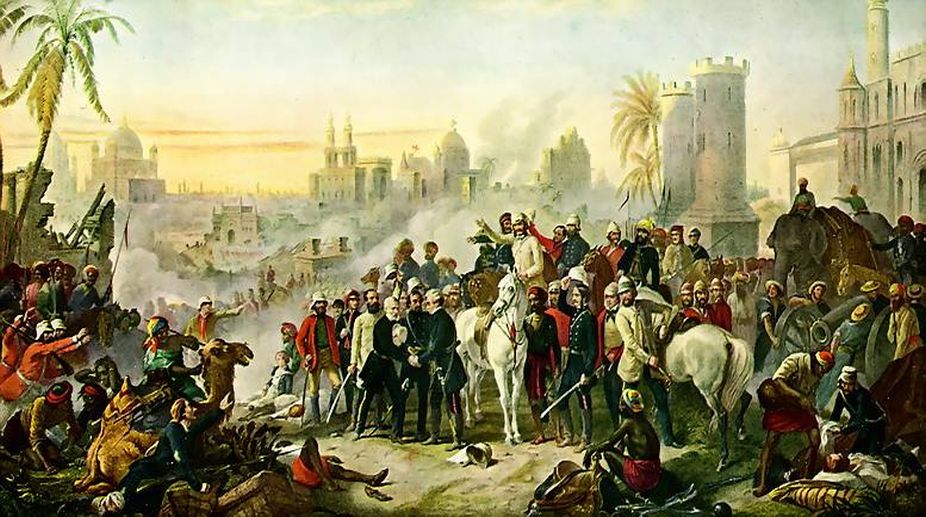It was on 11 May that the outbreak of the revolt of 1857 spread to Delhi from Meerut. The emperor, Bahadur Shah Zafar, was no doubt taken by surprise when the rebel sepoys reached the Capital via the Calcutta Gate, though they actually entered the Walled City through the Rajghat Gate in Daryaganj. However, two days earlier, in many homes in the Jama Masjid, Chandni Chowk and Mori Gate areas, gossip was rife that the days of the British Raj were over. Haji Zahooruddin, whose maternal grandfather was Maulvi Rajab Ali (the man who brought about Zafar’s surrender) used to say in 1957, when the centenary of the First War of Independence was observed, that the Maulvi had warned his family to be prepared for earth-shaking events that would make blood flow again on the streets of Delhi, as it did when Nadir Shah ordered the massacre in 1739. Maulvi Rajab Ali, incidentally, headed a secret service of his own.
In many other homes, like that of Lala Hanwant Sahai in Chandni Chowk, women used to collect every evening after their chores were done and talk of the predictions of Babbal (turmoil) by soothsayers following the appearance of the Jahoodar tara(comet) that appeared in the horizon at midnight behind the Red Fort. "It spells doom for the praja(subjects) or the ruler (the East India Company in this case)," they would mutter.
In Kutcha Mir Ashiq, just behind the Jama Masjid, where Maulvi Rajab Ali's son-in-law Munshi Turab Ali and his family used to stay, after the evening meal was cooked, the children were served dinner early and told to retire to bed and the elderly women sat down to talk of what fate might have in store.When the menfolk arrived they too joined in the hush-hush talk, bringing with them all the gup of the day. They told the women not to discuss their forebodings with neighbours as the Angrez Sarkar’s spies were all over the city and listening to conversations in streets, shops, eating houses and religious places. They were both Muslims and Hindus, some with long beards and black marks between the eyebrows which seemingly indentified them as piousnamazis, and others with big tilaks on their foreheads and dressed either like pandits, traders or as strangers from other cities, who showed curiosity in the everyday affairs in public places. There were Kutnis (women spies) too, eavesdropping at the zenanas.
In Kashmere Gate and the Civil Lines, Anglo-Indian and local Christian families had their own tales. The bearers and khansamas brought word from the bazaars that there were moves afoot to overthrow the Raj. George Heatherley's great-grandmother used to shake her head and say, "God knows what’s going to happen in Fajar (morning), for the sweeperwoman was saying, 'Memsahib, be prepared to flee somewhere, for fakirs like the Maulvi of Faizabad are sounding the alarm that the days of the infidels were numbered and the Padshah is going to rule again after every Firangi is either killed or jailed.' For the city, despite the bravado of the Skinner haveliwallahs and Metcalfe Sahib’s heir at Matka Kothi, has been shamed far too long by half-naked mems dancing unabashedly with males not even distantly related to them. The pork-eaters have profaned our hallowed Delhi, sacred to the 22 Khwajas or saints by not only eating forbidden food but also drinking at the Rauzas (mausoleums) and making love in them."
"Firdaus Jan, a dancing girl of Chawri Bazar, refused to sleep with a Gora who had entered her brothel at midnight, dead drunk and wearing only khaki knickers. The Gora created a scene and was beaten up by the Bharuas. But next day Firdaus and her pimps were arrested and taken to the police chowki, where they were flogged mercilessly and then put in the lockup, with poor Firdaus wearing just a torn petticoat that hardly hid her shame.”
This was stated by Sibbo the mehtrani, who cleaned the toilet of Nawabzada Mohd Ismail. She added that the Gora who wanted sexual favours the previous night was actually an Angez spy checking out on the ambience (fiza) in the red light area as the Firangis had got wind of the "seditious gossip" being spread in the mohallas and kutchas.
There was some truth in these happenings as long before May 11 the sadhus and fakirs had been going about asking people to clean their rusty talwars so that they could use them when the call for inquilab (revolution) came. They affirmed that the curse of 100 years after the Battle of Plassey, when the Raj came into being, was over and now the kafirs were going to be thrown back into the sea via which they entered the country as docile traders. One can vouch for these tales as in 1947 (90 years after the Great Revolt) Elias Nana proclaimed, while smoking his hookah, that the communal riots were in keeping with the trend of bloodshed that took place since 1556, when Hemu was defeated, 1667 that sparked the war of succession between the sons of Shah Jahan, 1757 when Clive won at Plassey, then the Ghadar and now almost a century later, a parting kick by the Ferangis to a newly-emerging India.
Whenever 11 May comes around such thoughts naturally come to mind though Nana has been dead for over 50 years and Siboo the sweeperess even longer, while the Nawabzada for whom she worked passed away much earlier and Nana’s maternal greatgrandson Noel, believe it or not, on the portentous 10 May, when the "Mutiny" broke out 140 years earlier at Meerut, in 1997, not far from the street named after the heroic Mangal Pandey, who started it all by refusing to bite the tainted grease cartridges.
What Delhi was like in 1857 is not difficult to imagine if you were to climb atop the Red Fort and look towards the Chandni Chowk and Jama Masjid. Many of the houses are still as they were during the Mutiny, except for the additional buildings that have come up to cope with the population explosion, making the old quarter little more than a rabbit's warren.
In those days the buildings were not high, through exceptions there were like the Lahore Bank and other such places where many of the British dwelt. That's an interesting point because it was only after the Great Revolt that the sahibs thought of living in separate areas to maintain their distance from the general populace. Safety was the primary purpose of this shift, which resulted in the creation of New Delhi on Raisina Hill.
The afternoon of May 10 this year was not as hot as it was in 1857 when the sepoys shot their British officers in Meerut and prepared to march to Delhi. Since it was a Sunday, that day in the Red Fort, 160 years ago, must have been a hectic one, what with all the rumours that had been floating for months about the impending end of the British Company Sarkar and the return of the Padshah and the Peshwa to their rightful places. The lotus and the chappati had made their rounds of the entire length and breadth of Hindustan, with runners fleeting away into the night through villages and towns to pass the word of the forthcoming event. And yet this year 10 May was a peaceful one in the fort with visitors, both Indian and foreign, trooping in and out of the Moghul places and the monkeys jabbering away in the trees or drinking water from the huge overhead tanks that feed the water supply to the barracks that have come up in place of the many royal buildings demolished after the Mutiny.
Trees seldom last that long and no wonder the one under which Bahadur Shah Zafar stood before bidding the final adieu to his palace, nay hearth and home, where he was born and brought up and attained an old, respectable age, is no longer there. But surely some of the remaining trees in the fort must have been witness to the gory events that followed the re-establishment of British authority because it was from them that the freedom fighters were hanged and their bodies left for the kites and the crows to feed on. Things associated with gruesome sights have a knack of fading away, perhaps in accordance with some natural law of retribution. The trees are no exception, for now only the neem thrives when in the past it must have been a poor cousin of the more favoured varieties of mainly fruit-bearing trees. The walls of the fort, however, still stand intact and making acquaintance with them yesterday brought a flood of thoughts in its wake.
Several monsoons have come and gone, washing many a building clean in the Capital, but the Khooni Darwaza in Bahadur Shah Zafar Marg retains its scars. Old timers say these are the blood stains of those killed at the historic gate and which continue to remind people in every generation of the atrocities of long ago. Among these was the murder of two sons and a grandson of Bahadur Shah, who were shot at the gate by a British officer Lt Hodson, after the uprising of 1857 had been quelled in Delhi.
The legend of the blood stains may be true, but what is intriguing about them is that they descend from top to bottom of the wall facing Maulana Azad Medical College. The sons and grandson of Bahadur Shah were killed by Hodson at the gate. Could it be that some others were butchered on top of it and then thrown down?











